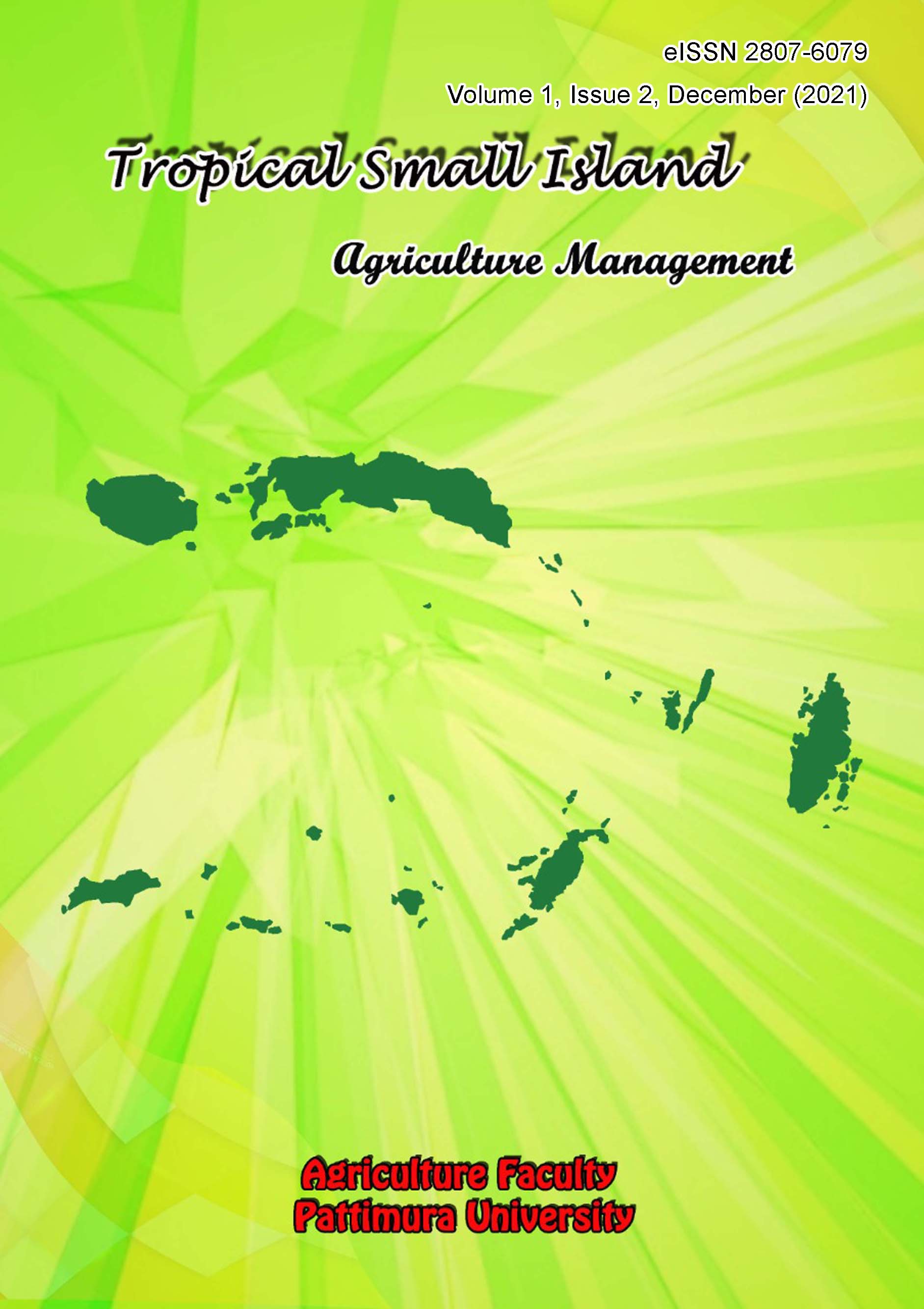Management of water resources in the Wae Rupa Watershed in the Perception of the Community of Hukurila Village, Ambon City
Abstract
Community-based water resources management is an approach that accommodates the active role of communities in protecting and conserving water resources. This research aims to analyze the correlation between the socio-economic characteristics of the community and community-based water resource management in Hukurila village, Ambon City. The data collection method uses interviews and field observations with data analysis using Rank-Spearman correlation to analyze the correlation between research parameters. This means that every form of natural resource utilization is carried out by considering watershed sustainability aspects. The analysis results of the community perceptions (knowledge and attitudes) assessment regarding community-based water resources management show that the level of community knowledge is in the high category, and the attitude assessment is in the medium category. The results of the Spearman Rank analysis between the level of knowledge and attitudes related to water resources management obtained a Spearman coefficient of 0.446 with a significance of 0.001 at the 99% confidence level. In comparison, the active attitude of the community with community-based watershed management obtained a Spearman coefficient of 0.337 with a significance of 0.017 at the 95% confidence level. Community perception, which includes community knowledge and attitudes, has a positive and significant relationship with sustainable and sustainable watershed management.
Downloads
References
Adams, M., & Moore, G. (2007). Participatory action research and researcher safety. In Participatory Action Research Approaches and Methods: Connecting People, Participation and Place. https://doi.org/10.4324/9780203933671-17
Darwis, R.S., Resnawaty, R., & Nuriyah, E. (2020). Peningkatan sensitivitas kepemimpinan lokal dalam pengelolaan Sungai Citarum melalui teknik Participatory Rural Appraisal (PRA) di Desa Rancamanyar. Kumawula: Jurnal Pengabdian Kepada Masyarakat, 3(1). https://doi.org/10.24198/kumawula.v3i1.24820
Fikar, Z., Masduqi, A., Masduqi, A., Endah, N., & Soedjono, E. S. (2008). Sistem penyediaan air bersih perdesaan berbasis masyarakat. Jurnal Seminar Pascasarjana, 1–6.
Hidayat, A. (2017). Metode Penelitian: Pengertian, Tujuan, Jenis - Uji Statistik. www.statistikian.com.
Kadri, T. (2005). Menelaah strategi pengelolaan DAS di Indonesia (Sebuah Kritik). Sipil, 5(1), 32-40.
Kodoatie, Robert J. & Syarief, R. (2010). Tata Ruang Air Tanah. Yogyakarta: Andi Press, 7.
Latuamury, B., Aponno, H.S.E.S., Marasabessy, H., Hadijah, M.H., & Imlabla, W. (2020). The spatial dynamics of land cover change along the Wallacea corridor in the key biodiversity area ‘Buano Island’, Maluku, Indonesia. Journal of Degraded and Mining Lands Management, 7(4), 2241-2251. https://doi.org/10.15243/JDMLM.2020.074.2241
Latuamury, Bokiraiya. (2013). Hubungan antara indeks vegetasi NDVI (Normalized Difference Vegetation Index) dan koefisien resesi baseflow pada beberapa Subdas Propinsi Jawa Tengah dan Daerah Istimewa Yogyakarta. Jurnal Teknosains, 2(2), 71–92. https://doi.org/10.22146/teknosains.5998
Latuamury, B. (2020a). Manajemen DAS Pulau-Pulau Kecil. Deepublish.
Latuamury, B. (2020b). Pemodelan Perubahan Penggunaan Lahan dan Karaketristik Resesi Aliran dasar Sungai. Deepublish.
Latuamury, B. (2022). Buku Ajar Hidrologi Pulau Kecil (p. 313). Deepublish.
Latuamury, B. (2023). Buku Ajar Konservasi Tanah Dan Air (p. 286). Deepublish.
Marasabessy, S., Latuamury, B., Iskar, I., & Suhendy, C.C.V. (2019). Persepsi masyarakat mengenai peranan vegetasi kawasan sabuk hijau di Sempadan Sungai DAS Wae Batu Gajah. MAKILA, 13(1), 14-28. https://doi.org/10.30598/makila.v13i1.2317
Parera, A.A., Kastanya, A., & Tjoa, M. (2021). Hubungan modal sosial kognitif terhadap performansi dusung di Desa Murnaten Kecamatan Taniwel. Makila, 15(1), 70–79. https://doi.org/10.30598/makila.v15i1.3266
Rinaldi, S. F., & Mujianto, B. (2017). Metode Penelitian Dan Statistik. Pusat Pendidikan Sumber Daya Manusia Kesehatan.
Santikayasa, I.P. (2018). Pengelolaan Sumberdaya Air Pada Berbagai Skenario Perubahan Iklim Menggunakan WEAP. Seminar Nasional Geomatika, 2. https://doi.org/10.24895/sng.2017.2-0.432
Satriani, G., & Ihsan, M. (2013). Persepsi dan sikap masyarakat terhadap penerapan program pemberdayaan di sekitar Sub Daerah Aliran Sungai MIU (Kasus program SCBFWM di Desa Simoro Kecamatan Gumbasa Kabupaten Sigi). Jurnal Warta Rimba, 1(1), 1–10.
Satriawan, H. (2017). Strategi pengelolaan Daerah Aliran Sungai (DAS) dalam rangka optimalisasi kelestarian sumberdaya air (Studi kasus DAS Peusangan Aceh). Majalah Ilmiah Universitas Almuslim, 9.
Sukwika, T. (2019). Partisipasi masyarakat menyediakan jasa lingkungan hidrologis di kawasan daerah aliran sungai. Sustainable Environmental and Optimizing Industry Journal, 1, 49–58.
Susetyo, D.I.N., & Cahyono. (2017). Analisis faktor-faktor yang mempengaruhi pengembangan kawasan pariwisata bahari di Gili Labak, Kabupaten Sumenep. Jurnal Teknik ITS, 6(1).
Copyright (c) 2024 The Author(s)

This work is licensed under a Creative Commons Attribution-ShareAlike 4.0 International License.
Authors who publish with this journal agree to the following terms:
- Authors retain copyright and grant the journal right of first publication with the work simultaneously licensed under a Creative Commons Attribution License that allows others to share the work with an acknowledgment of the work's authorship and initial publication in this journal.
- Authors are able to enter into separate, additional contractual arrangements for the non-exclusive distribution of the journal's published version of the work (e.g., post it to an institutional repository or publish it in a book), with an acknowledgment of its initial publication in this journal.
- Authors are permitted and encouraged to post their work online (e.g., in institutional repositories or on their website) prior to and during the submission process, as it can lead to productive exchanges, as well as earlier and greater citation of published work (See The Effect of Open Access).









